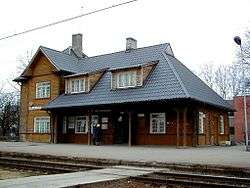Carnikava
Carnikava (Livonian: Sarnikau, German: Koivemund, Zarnikau) is a village and the center of Carnikava Municipality, Latvia, located 25 km north from Riga at the mouth of the Gauja River. Carnikava had 4689 residents as of January 2020.[1]
Carnikava | |
|---|---|
Village | |
 Railway station in Carnikava | |
 Carnikava Carnikava's location in Latvia | |
| Coordinates: 57°8′0″N 24°17′0″E | |
| Country | |
| Municipality | Carnikava |
| Area | |
| • Land | 4,93 km2 (190 sq mi) |
| Elevation | 6 m (20 ft) |
| Population (2020) | |
| • Total | 4,689 |
| Time zone | UTC+2 (EST) |
| • Summer (DST) | UTC+3 (EEST) |
| Post code | LV-2163 |
The village was first mentioned in Livonian Chronicle of Henry in 1211 as a summoning place of Livonian troops. Later Carnikava grew into a fishermen village, where in the 17th century the first breeding fishery and canned fish factory in the Russian Empire was built. Due to its proximity to the Baltic Sea, several forest lakes, the Gauja and annual fishermen and craftsmanship fairs, nowadays Carnikava is a popular summer resort among visitors from Riga.
A notable symbol and long-time specialty of Carnikava has been grilled lamprey, which is also pictured on the coat of arms of the municipality.[2]
Heinz Christian Pander (1794-1865), researcher of biology, embryology and paleontology, lived and worked in Carnikava in his estate.
References
- "Vietvārdu datubāze" [Placename Database]. vietvardi.lgia.gov.lv (in Latvian). Retrieved 2020-05-22.
- "Carnikava district". tourism.carnikava.lv. Retrieved 2020-05-22.